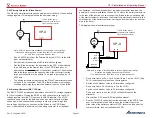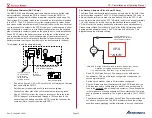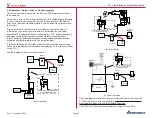
Page 20
VP-X Installation and Operating Manual
Rev. D (August 5, 2020)
4.7c Pin Removal Tool
A pin removal tool is included with the wiring harness or connector kit.
Pin Removal Tool
If the pin removal tool is not working as expected, use a Scotchbrite wheel to
grind the end of the pin removal tool as shown below.
Incorrect
Correct
4.8 Alternator and Voltage Regulator Considerations
Choosing the correct alternator and voltage regulator is an important part of
planning your electrical system. The VP-X supports internally and externally
regulated alternators, as well as the B&C SD-8 permanent magnet alternator.
We do not take a position regarding which type or brand of alternator is best.
The VP-X does NOT replace the voltage regulator. Externally-regulated
alternators require a voltage regulator.
The typical automotive-style voltage regulator does simply that – regulates
the voltage to the field wires on the alternator. Varying the field voltage affects
the output capacity of the alternator. Higher voltage means a stronger field to
generate current which means more output. An internally regulated alternator
provides the same function, but the regulator is housed in the alternator itself.
Certain internally regulated alternators provided by Plane Power, Ltd. (
) have built in over-voltage protection. All alternators built by
Plane Power are compatible with the VP-X system.
Externally-regulated alternators have the regulator in a separate box outside
the alternator. Most voltage regulators provide only the voltage regulation
function, and some allow you to adjust the voltage level. The B&C LR-3C
(
) external voltage regulator provides three functions: 1)
voltage regulation, 2) under-voltage alerting, and 3) overvoltage protection. It
is generally regarded as a high-quality product that has been through years
of field experience. Note: B&C does not recommend the LR-3C be connected
to PTCs (Positive Temperature Coefficient thermistor) for circuit protection.
The VP-X does not use PTCs for the power circuits and is compatible with
B&C voltage regulators.
There is a long-standing and unresolved debate in the experimental
community about the benefits of internally versus externally regulated
alternators. The table below shows some of the pros and cons of each type.
Some common backup alternators are the accessory-drive mounted SD-20
alternator and the SD-8 PM alternator, both available from B&C Specialty
Products. The one you choose is driven in large part by the size of the loads
you need the backup alternator to carry.
Pros
Cons
Internally
Regulated
Alternator
Simple to wire
No external boxes
Certain failure modes
will cause over-voltage
condition that cannot be
stopped by removing
power from the field wire*.
Externally
Regulated
Alternator
Separation of VR from
alternator, and each can
be serviced separately.
Removal of power from
regulator shuts down
alternator.
Extra box to install and
wire
Extra cost and weight







































